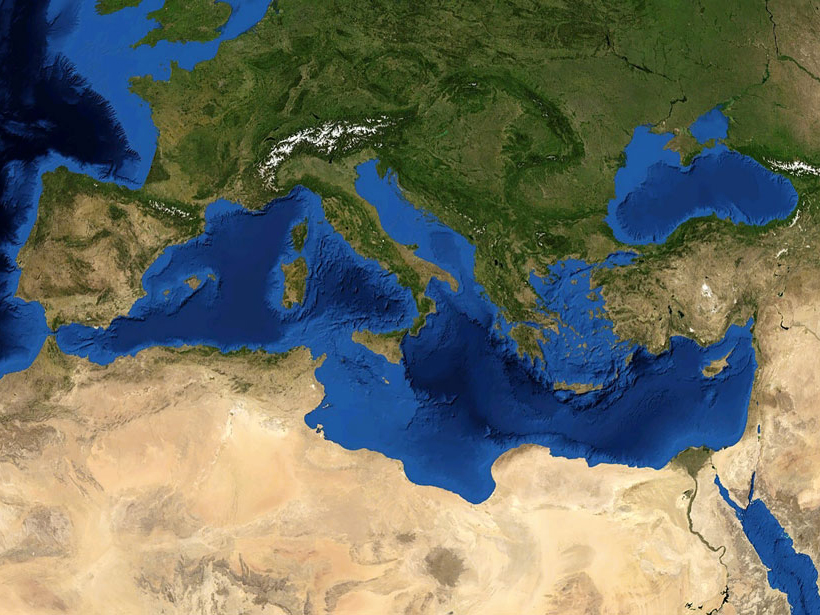Records of tsunamis and coastal storms abound along the Mediterranean seaboard, home to large cities such as Istanbul, Tel Aviv, and Naples and roughly 130 million people. But differentiating between these two types of natural disasters, which is critical for accurately estimating their relative risks, is challenging because they both sweep sedimentary material inland.
Now, scientists have compared a 4,500-year record of purported tsunami events with climate records and have shown that roughly 90% of the “tsunami” events were correlated with periods of increased storminess. That correlation suggests that many of the deposits attributed to tsunamis were, in fact, likely left by coastal storms, the researchers report, a finding that highlights the relatively larger importance of storms as agents of change in the Mediterranean.
“Mediterranean research has been significantly skewed towards tsunami work.”
“Both tsunamis and storms have the potential to significantly affect coastal geomorphology and populations living in seaboard areas,” said geographer and research team member Nick Marriner of the French National Center for Scientific Research in Besançon. “But storms have been underestimated in the Mediterranean’s geological record, and Mediterranean research has been significantly skewed towards tsunami work.”
Clusters of Tsunamis?
Marriner and his colleagues combed through the published literature to compile stratigraphic records of tsunamis that occurred over the last 4,500 years and found 135 tsunami events spread across eight countries: Algeria, Cyprus, Egypt, Greece, Israel, Italy, Spain, and Turkey. From the distribution of ages of the purported tsunamis, the team found evidence for three previously unrecognized periods of unusually frequent tsunami occurrences at intervals of roughly 1,500 years. Each of these “tsunami megacycles” lasted for roughly 300–400 years and included 11–26 events.
The researchers then extracted climate data from geological records, like sediment cores, obtained across Europe to estimate trends in temperature, storminess, and windiness. They found that the peaks in the tsunami megacycles tended to occur during times of windier and stormier conditions in the North Atlantic and also when the climate was generally cooler. “Ninety percent of the sedimentary events interpreted as tsunamis share chronological intercepts with periods of heightened storm activity in the Mediterranean,” the team reported in Science Advances on 11 October.
Storms Masquerading as Tsunamis
These correlations were red flags that the tsunami records might not actually be reflecting true tsunami events. “Tsunamis should not be correlated with climate cycles because they are caused by seismic events, underwater landslides, or meteor impacts,” said Marriner. The team concluded that up to 123 of the 135 events believed to be tsunamis might, in fact, be records of storms.
“This study is a wake-up call for those working on tsunamis and storm deposits.”
“I hope that this study is a wake-up call for those working on tsunamis and storm deposits that we need to push our understanding…to minimize identification errors,” said Robert Weiss, a natural hazards scientist at Virginia Tech in Blacksburg not involved in the research.
Geological Detective Work
It is important to plan for tsunami events, but it is also important not to underestimate the role of storms, said Marriner. An international database of disasters shows that the latter are actually much deadlier and costlier than tsunamis, he added. Between 1900 and 2015, storms accounted for more than 80% of the deaths and financial losses from these two types of natural disasters.
These findings highlight the importance of using multiple streams of evidence to make inferences about the distant past, said Jessica Pilarczyk, a coastal geologist at the NASA Stennis Space Center campus of the University of Southern Mississippi who was not involved in the research. “Interpreting the geologic record involves detective work,” Pilarczyk said.
—Katherine Kornei (email: [email protected]; @katherinekornei), Freelance Science Journalist
Citation:
Kornei, K. (2017), Storms may have produced most Mediterranean “tsunami” deposits, Eos, 98, https://doi.org/10.1029/2017EO085093. Published on 18 October 2017.
Text © 2017. The authors. CC BY-NC-ND 3.0
Except where otherwise noted, images are subject to copyright. Any reuse without express permission from the copyright owner is prohibited.

